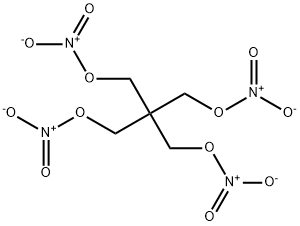
Pentaerythritol tetranitrate
- Product NamePentaerythritol tetranitrate
- CAS78-11-5
- CBNumberCB4292971
- MFC5H8N4O12
- MW316.14
- EINECS201-084-3
- MDL NumberMFCD00058681
- MOL File78-11-5.mol
Chemical Properties
| Melting point | 140° |
| Boiling point | 455.59°C (rough estimate) |
| Density | d420 1.773 |
| refractive index | 1.7900 (estimate) |
| storage temp. | -20°C |
| solubility | Practically insoluble in water, soluble in acetone, slightly soluble in ethanol (96 per cent). The solubility of diluted pentaerythrityl tetranitrate depends on the diluent and its concentration. |
| color | Crystals or prisms from Me2CO/EtOH |
| Water Solubility | 2mg/L(temperature not stated) |
| Stability | Stable, but decomposes readily and possibly explosively if heated. Incompatible with strong oxidizing agents. Store cold and keep away from sources of ignition. |
| FDA 21 CFR | 250.102 |
| EWG's Food Scores | 1-4 |
| FDA UNII | 10L39TRG1Z |
| NCI Drug Dictionary | Peridex |
| ATC code | C01DA05,C01DA55 |
| NIST Chemistry Reference | Pentaerythritol, tetranitrate(78-11-5) |
| EPA Substance Registry System | Pentaerythritol tetranitrate (78-11-5) |
| UNSPSC Code | 41116107 |
| NACRES | NA.24 |
Safety
| Symbol(GHS) |

|
| Signal word | Danger |
| Hazard statements | H201 |
| Precautionary statements | P210-P230-P240-P250-P280-P370+P380-P372-P373-P401-P501 |
| Hazard Codes | E,Xn |
| Risk Statements | 3-36-20/21/22-11 |
| Safety Statements | 35-36/37-26-16 |
| RIDADR | 0473 |
| HazardClass | 1.1A |
| PackingGroup | II |
| Hazardous Substances Data | 78-11-5(Hazardous Substances Data) |
| Toxicity | LD50 oral in rat: 1660mg/kg |
